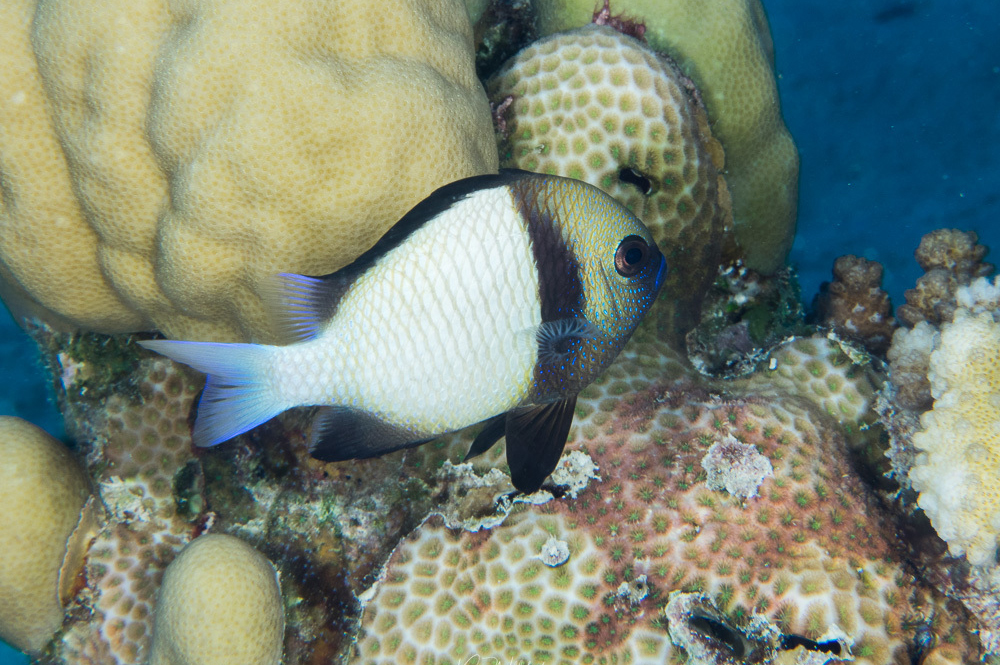Cloudy Dascyllus, Dascyllus carneus Fischer 1885
Other Names: Cardinal Humbug, Indian Dascyllus, Twobar Humbug

A Cloudy Dascyllus, Dascyllus carneus, at Home Island, Cocos (Keeling) Islands, eastern Indian Ocean, June 2016. Source: cocos_karen / iNaturalist.org. License: CC By Attribution-NonCommercial
Summary:
A pearly-white damselfish with a slightly darker head covered in small dark-rimmed blue spots, a black band through the pectoral-fin base, a very broad black margin on the spinous dorsal fin, and black anal and pelvic fins.
Cite this page as:
Bray, D.J. 2025, Dascyllus carneus in Fishes of Australia, accessed 03 Jul 2025, https://fishesofaustralia.net.au/Home/species/5548
Cloudy Dascyllus, Dascyllus carneus Fischer 1885
More Info
|
Distribution |
Cocos (Keeling) Islands in the eastern Indian Ocean. Elsewhere the species is widespread in the Indian Ocean, from South and East Africa, to the Andaman Sea, western Indonesia and the Cocos (Keeling) Islands. Small schools inhabit inshore and offshore reefs, living in association with branching corals. |
|
Features |
Dorsal fin usually XII,15; Anal fin usually 11,13; Pectoral fin usually 20-21; Tubed lateral-line scales usually 17-18; Gill rakers, first arch usually 7 + 17-20. Greatest body depth 1.5-1.6 in SL; head length 3.0-3.4 in SL; snout length 3.4-4.0 in HL; eye diameter 2.1-2.4 in HL; interorbital width 2.9-3.4 in HL; least depth of caudal peduncle 1.7-2.0 in HL. |
|
Colour |
Pearly-white with a slightly darker head, a black band from the first dorsal fin through the pectoral-fin base to the pelvic fins, a small dark-rimmed blue spots on the head, nape and breast, a very broad black margin on the spinous dorsal fin, black anal and pelvic fins, bluish soft dorsal and caudal fins, and often a black band before the caudal peduncle that extends onto the soft dorsal and anal fins. |
|
Feeding |
Hovers above branching corals feeding on zooplankton. |
|
Biology |
Species of the genus Dascyllus are obligate coral dwellers. Some, including D. carneus, are protogynous hermaphrodites, with females having the ability to change sex during their life cycle. One or two dominant males defend a single branching coral head with a harem of juveniles and females. In return for the shelter provided by the coral, the fish remove unwanted algal growth from the coral. Females spawn demersal adhesive eggs that are guarded by the male parent until the larvae hatch. |
|
Similar Species |
The Cloudy Dascyllus differs from the similar Headband Humbug, Dascyllus reticulatus, in having blue spots on the head and nape, attaining a smaller maximum size of about 50 mm, with males attain sexual maturity between 30-35 mm (vs. males maturing between 45-55 mm, with a size of about 65 mm in D. reticulatus), and in having a naked area on the chin anterior to the forward extension of the isthmus (vs, largely covered with scales in D. reticulatus) |
|
Etymology |
The specific name is from the Latin carneus (= of flesh, flesh-coloured) presumably in reference to the off-white body colour. |
|
Species Citation |
Dascyllus carneus Fischer 1885, Jahrbuch der Hamburgischen Wissenschaftlichen Anstalten 2: 71, Pl. 2 (fig. 5). Type locality: Mozambique, western Indian Ocean |
|
Author |
Bray, D.J. 2025 |
|
Resources |
Cloudy Dascyllus, Dascyllus carneus Fischer 1885
References
Allen, G. R. 1986. Family 219: Pomacentridae. pp. 670-682 in Smith, M.M. & Heemstra, P.C. (eds). Smith's Sea Fishes. Johannesburg : Macmillan South Africa xx + 1047 pp. 144 pls. See ref at BHL
Allen, G.R. 1991. Damselfishes of the World. Melle, Germany : Mergus Verlag 271 pp.
Allen, G. R. 2001. Family Pomacentridae. pp. in Carpenter, K.E. & Niem, T.H. (eds). The Living Marine Resources of the Western Central Pacific. FAO Species Identification Guide for Fisheries Purposes. Rome : FAO Vol. 6 pp. 3381-4218.
Allen, G.R. 2022. Dascyllus carneus. The IUCN Red List of Threatened Species 2022: e.T188568A1894672. https://dx.doi.org/10.2305/IUCN.UK.2022-2.RLTS.T188568A1894672.en. Accessed on 21 September 2023.
Allen, G.R. & Erdmann, M.V. 2012. Reef fishes of the East Indies. Perth : Tropical Reef Research 3 vols, 1260 pp.
Anzeer, M.F., Aneesh, K.S., Abraham, M.V., et al. 2019. Breeding, early development and larval rearing of cloudy damsel, Dascyllus carneus Fischer, 1885. Aquaculture 505: 374-385. https://doi.org/10.1016/j.aquaculture.2019.03.001
Asoh, K. & Yoshikawa, T. 2003. Gonadal development and an indication of functional protogyny in the Indian damselfish (Dascyllus carneus). Journal of Zoology 260: 23-39. https://doi.org/10.1017/S0952836903003418
Fischer, J.G. 1885. II. Über einige afrikanische Fische des Naturhistorischen Museums in Hamburg (2). pp. 66-77 in Ichthyologische und herpetologische Bemerkungen. Jahrbuch der Hamburgischen Wissenschaftlichen Anstalten 2: 49-121, Pls. 1-4.
Hobbs, J-P.A., Newman, S .J., Mitsopoulos, G.E.A., Travers, M.J., Skepper, C.L., Gilligan, J.J., Allen, G.R., Choat, H.J. & Ayling, A.M. 2014. Fishes of the Cocos (Keeling) Islands: new records, community composition and biogeographic significance. Raffles Bulletin of Zoology Supplement 30: 203–219 https://lkcnhm.nus.edu.sg/rbz/supplement-no-30/
Ladiges, W., Wahlert, G. von & Mohr, E. 1958. Die Typen und Typoide der Fischsammulung des Hamburgischen Zoologischen Staatsinstituts und Zoologischen Museums. Mitteilungen aus dem Hamburgischen Zoologischen Museum und Institut 56: 155-167
Randall, H.A. & Allen, G.R. 1977. A revision of the damselfish genus Dascyllus (Pomacentridae) with the description of a new species. Records of The Australian Museum 31(9): 349-385. https://doi.org/10.3853/j.0067-1975.31.1977.217
Regan, C. T. 1908. Report on the marine fishes collected by Mr. J. Stanley Gardiner in the Indian Ocean. Transactions of the Linnean Society of London, 2nd ser., 12: 217-255 (described as Dascyllus nigripinnis)
Shpigel M. & Fishelson L. 1986. Behaviour and physiology of coexistence in two species of Dascyllus (Pomacentridae, Teleostei). Environmental Biology of Fishes 17: 253-265.







